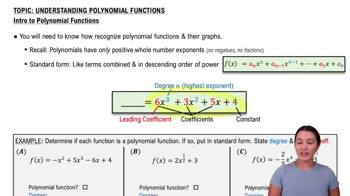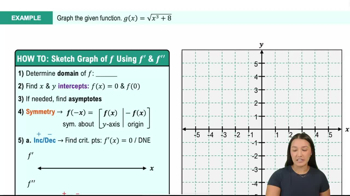Table of contents
- 0. Functions7h 52m
- Introduction to Functions16m
- Piecewise Functions10m
- Properties of Functions9m
- Common Functions1h 8m
- Transformations5m
- Combining Functions27m
- Exponent rules32m
- Exponential Functions28m
- Logarithmic Functions24m
- Properties of Logarithms34m
- Exponential & Logarithmic Equations35m
- Introduction to Trigonometric Functions38m
- Graphs of Trigonometric Functions44m
- Trigonometric Identities47m
- Inverse Trigonometric Functions48m
- 1. Limits and Continuity2h 2m
- 2. Intro to Derivatives1h 33m
- 3. Techniques of Differentiation3h 18m
- 4. Applications of Derivatives2h 38m
- 5. Graphical Applications of Derivatives6h 2m
- 6. Derivatives of Inverse, Exponential, & Logarithmic Functions2h 37m
- 7. Antiderivatives & Indefinite Integrals1h 26m
- 8. Definite Integrals4h 44m
- 9. Graphical Applications of Integrals2h 27m
- 10. Physics Applications of Integrals 2h 22m
5. Graphical Applications of Derivatives
Curve Sketching
Problem 25
Textbook Question
Use the guidelines given in Section 4.4 to make a complete graph of the following functions on their domains or on the given interval. Use a graphing utility to check your work.
ƒ(x) = (x⁴/2) - 3x² + 4x + 1
 Verified step by step guidance
Verified step by step guidance1
Identify the function: \( f(x) = \frac{x^4}{2} - 3x^2 + 4x + 1 \). This is a polynomial function of degree 4.
Find the derivative \( f'(x) \) to determine critical points and analyze the behavior of the function. Use the power rule to differentiate: \( f'(x) = 2x^3 - 6x + 4 \).
Set \( f'(x) = 0 \) to find critical points: \( 2x^3 - 6x + 4 = 0 \). Solve this equation to find the values of \( x \) where the function's slope is zero, indicating potential maxima, minima, or points of inflection.
Find the second derivative \( f''(x) \) to analyze concavity: \( f''(x) = 6x^2 - 6 \). Use \( f''(x) \) to determine intervals where the function is concave up or concave down, and identify any points of inflection.
Evaluate the function \( f(x) \) at the critical points and endpoints of the interval to determine the local and global extrema. Use these values to sketch the graph, ensuring to check your work with a graphing utility.
 Verified video answer for a similar problem:
Verified video answer for a similar problem:This video solution was recommended by our tutors as helpful for the problem above
Video duration:
25mPlay a video:
Was this helpful?
Key Concepts
Here are the essential concepts you must grasp in order to answer the question correctly.
Polynomial Functions
Polynomial functions are mathematical expressions involving variables raised to whole number powers, combined using addition, subtraction, and multiplication. The function given, ƒ(x) = (x⁴/2) - 3x² + 4x + 1, is a polynomial of degree four, which means its highest exponent is four. Understanding the general shape and behavior of polynomial functions is crucial for graphing them accurately.
Recommended video:

Introduction to Polynomial Functions
Graphing Techniques
Graphing techniques involve methods to visualize functions on a coordinate plane. This includes identifying key features such as intercepts, turning points, and asymptotic behavior. For polynomial functions, one can find critical points by taking the derivative, which helps in determining where the function increases or decreases, aiding in sketching the graph.
Recommended video:

Graphing The Derivative
Using Graphing Utilities
Graphing utilities are software or online tools that allow users to plot functions quickly and accurately. They can provide visual representations of functions, making it easier to verify the results obtained through manual graphing. Utilizing these tools can enhance understanding of the function's behavior and confirm the accuracy of the graph created by hand.
Recommended video:

Graphing The Derivative

 11:41m
11:41mWatch next
Master Summary of Curve Sketching with a bite sized video explanation from Callie
Start learning




